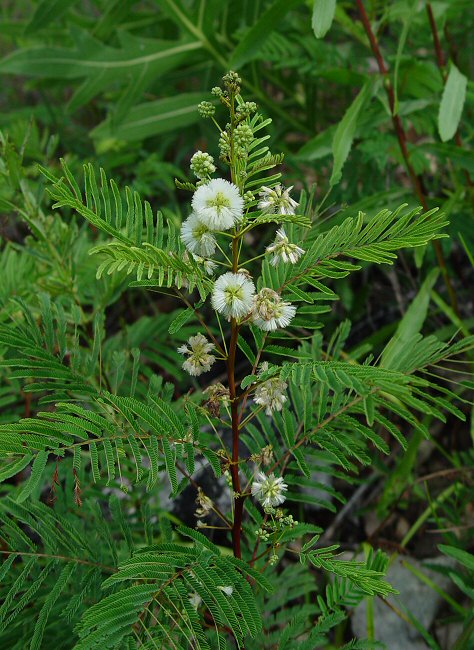Acaciella angustissima (Mill.) Britton & Rose
Prairie Acacia

Native
CC = 10
CW = 5
MOC = 12
© DETenaglia
Acaciella angustissima (Mill.) Britton & RosePrairie Acacia | |
 |
Native CC = 10 CW = 5 MOC = 12 |
© DETenaglia |
|
Family - Fabaceae/Mimosoideae Habit - Perennial forbs from a woody, rhizomatous rootstock, sometimes becoming a shrub. Stems - Multiple from a woody crown, to 1m tall, red in strong sunlight, carinate, stout, erect, branching, herbaceous to suffrutescent, with pustulate-based hairs (the base of the hairs giving the stems a scabrous feel).
Leaves - Alternate, petiolate, stipulate, bipinnate (even), to +15cm long. Petioles to 3cm long, lacking glands. Expanded portion at the base of the petiole to 3mm long. Petioles and rachis with shallow adaxial groove, pubescent as the stem. Stipules thin and dry, ferruginous, ~3mm long, ~.5mm wide, with ciliate margins, other wise glabrous. Pinnae opposite to sub-opposite, +/-11 per side. Petiolules of pinnae -1mm long, antrorse pubescent. Leaf divisions with many pinnules (+/-50 per margin). Pinnules -4mm long, -1.5mm broad, acute, entire, oblique at the base, dull green above, light green below with a dark green midrib, with a few sparse hairs at the margins.
Inflorescence - Pedunculate, axillary globose clusters mostly in the apical half of the stem. Peduncles light green, sparse antrorse pubescent, carinate, +/-2cm long. Pedicels light green, to 1mm long. Flowers +/-25 per head.
Flowers - Petals 5, green, erect, united at the very base, glabrous, acute, to -3mm long, 1mm broad, oblong elliptic. Calyx greatly reduced, .7mm long with very shallow lobes. Stamens very numerous (+100), well exserted from the perianth. Filaments white, glabrous, 5-8mm long, capillary. Anthers pale yellow, .1mm broad. Ovary superior, green, 1-1.2mm long in flower, .5mm in diameter, cylindric, subtended by a yellow ring-like nectary. Stipe .5-.7mm long. Style 1, as long as the filaments, light green, 3-4mm long. Fruits not seen.
Flowering - June - October. Habitat - Rocky glades, open hillsides, exposed ledges along bluffs. Origin - Native to U.S., Central and South America, Australia, Africa. Other info. - This species can be found in the southwest corner of Missouri. The plant reaches the northeastern edge of its range in Missouri. It is much more common in the southwestern U.S. Photographs taken at Busiek State Forest, MO., 6-17-05. |